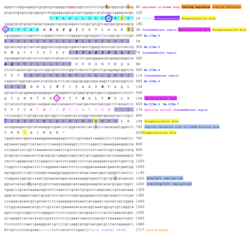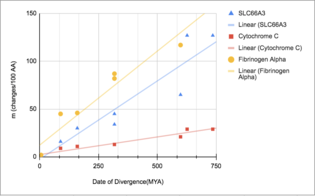| SLC66A3 | |||||||||||||||||||||||||||||||||||||||||||||||||||
|---|---|---|---|---|---|---|---|---|---|---|---|---|---|---|---|---|---|---|---|---|---|---|---|---|---|---|---|---|---|---|---|---|---|---|---|---|---|---|---|---|---|---|---|---|---|---|---|---|---|---|---|
| Identifiers | |||||||||||||||||||||||||||||||||||||||||||||||||||
| Aliases | SLC66A3, C2orf22, PQ loop repeat containing 3, solute carrier family 66 member 3, PQLC3 | ||||||||||||||||||||||||||||||||||||||||||||||||||
| External IDs | MGI: 2444067; HomoloGene: 16454; GeneCards: SLC66A3; OMA:SLC66A3 - orthologs | ||||||||||||||||||||||||||||||||||||||||||||||||||
| |||||||||||||||||||||||||||||||||||||||||||||||||||
| |||||||||||||||||||||||||||||||||||||||||||||||||||
| |||||||||||||||||||||||||||||||||||||||||||||||||||
| |||||||||||||||||||||||||||||||||||||||||||||||||||
| Wikidata | |||||||||||||||||||||||||||||||||||||||||||||||||||
| |||||||||||||||||||||||||||||||||||||||||||||||||||
Solute carrier family 66 member 3 is a gene in humans that encodes the protein SLC66A3. The function of the SLC66A3 protein is not yet well understood but belongs to a family of five evolutionarily related proteins, the SLC66 lysosomal amino acid transporters. SLC66A3 is localized to the endoplasmic reticulum and has four transmembrane domains.
Gene
The SLC66A3 is a gene consisting of 26,831 base pairs spanning from 11,155,467 to 11,178,856 on chromosome 2. SLC66A3 mapped to the plus strand at 2p25.1 and contains 7 exons. The SLC66A3 gene is neighbored by the genes ROCK2, C2orf50, and KCNF1. ROCK2 and C2orf50 are both located upstream of SLC66A3 whereas KCNF1 is located upstream.

Transcripts
SLC66A3 has 14 different mRNAs, there are 12 alternatively-spliced mRNAs that produce functional proteins and 2 unspliced variations that do not. The longest transcript is transcript variant 1 which produces the longest protein at 202 amino acids in length.
Protein
The SLC66A3 protein coding gene that produces a protein with the same name. The mRNA transcript variant 1 is 1,717 bp with 7 exons and produces the longest protein, transcript variant 1. SLC66A3 is a 202 amino acid, 22.6 kDa protein with a theoretical isoelectric point of 9.14.

Secondary structure
The secondary structure of SLC66A3 is predicted to consist of 7 α-helices. The protein contains a signal peptide, 4 transmembrane regions, and a splicing variant region, and is localized in the endoplasmic reticulum.
Tertiary structure
I-TASSER predicts that the tertiary structure contains 7 coils with high certainty. DiANNA predicts disulfide bonds between positions 9 - 57, 17 - 121, and 82 - 157.
Gene level regulation
Promoter
The promoter of SLC66A3 is 1,169 base pairs long and is located 1000 base pairs upstream of the 5' UTR.
Transcription factors
Many different transcription factors regulate the expression of the SLC66A3 gene. Some of these include RNA polymerase II transcription factor II B, Myc associated zinc fingers, EGR/nerve growth factor induced protein C & related factors, and EVI1-myeloid transforming protein.
| Transcription Factor | Function |
|---|---|
| RNA polymerase II transcription factor II B | Stimulation of transcription initiation. |
| EVI1-myleoid transforming protein | Involved in the proliferation and differentiation of hematopoietic cells through interaction with GATA-2. |
| Krueppel like transcription factors | Involved in β-globin expression and the development of erythrocytes. |
| GATA binding factors | Involved in the regulation of transcription during developmental stages and maintaining and developing hematopoietic systems. |
Expression patterns
SLC66A3 is expressed at high levels in a variety of tissues throughout the body but is most highly abundant in the whole blood and white blood cells. SLC66A3 is expressed at high levels, approximately 2.1 times more than the average gene.
Protein Level Regulation
Post translational modifications
SLC66A3 is predicted to undergo phosphorylation, N-glycosylation, and myristoylation.
Homology/Evolution

Orthologs
SLC66A3 was present in the common ancestor of animals and is found in all animals but not fungi.
| Genus, Species | Common Name | Taxonomic Group | Divergence date from humans (MYA) | accession number | Sequence Length(AA) | Sequence Identity(%) |
| Homo sapiens | Human | Primates | 0 | NP_689604.1 | 202 | 100 |
| Mus musculus | Mouse | Rodentia | 89 | NP_766162.2 | 202 | 85 |
| Phascolarctos cinereus | Koala | Marsupialia | 160 | XP_020841056.1 | 203 | 74 |
| Anolis carolinensis | Green anole | Squamata | 318 | XP_003215467.1 | 202 | 64 |
| Gallus gallus | Chicken | Galliformes | 318 | XP_040524789.1 | 201 | 71 |
| Danio rerio | Zebrafish | Cypriniformes | 433 | NP_001004615.1 | 203 | 59 |
| Electrophorus electricus | Electric eel | Gymnotiformes | 433 | XP_026863988.2 | 203 | 58 |
| Callorhinchus milii | Elephant shark | Chimaera | 465 | XP_007895274.1 | 218 | 59 |
| Petromyzon marinus | Sea lamprey | Petromyzontiformes | 599 | XP_032825995.1 | 201 | 52 |
| Crassostrea gigas | Pacific oyster | Ostreida | 736 | XP_034312411.1 | 208 | 36 |
| Drosophila willistoni | Fruitfly | Diptera | 736 | XP_002074377.2 | 220 | 34 |
| Owenia fusiformis | Tube worm | Canalipalpata | 736 | CAC9661908.1 | 233 | 29 |
| Lytechinus variegatus | Variegated sea urchin | Temnopleuroida | 627 | XP_041484893.1 | 224 | 29 |
| Asterias rubens | Common starfish | Forcipulatida | 627 | XP_033644897.1 | 213 | 28 |
| Amphimedon queenslandica | Sponge | Haplosclerida | 777 | XP_019856231.1 | 221 | 26 |
References
- ^ GRCh38: Ensembl release 89: ENSG00000162976 – Ensembl, May 2017
- ^ GRCm38: Ensembl release 89: ENSMUSG00000045679 – Ensembl, May 2017
- "Human PubMed Reference:". National Center for Biotechnology Information, U.S. National Library of Medicine.
- "Mouse PubMed Reference:". National Center for Biotechnology Information, U.S. National Library of Medicine.
- Gyimesi G, Hediger MA (2021-06-25). "SLC66 Lysosomal amino acid transporters in GtoPdb v.2021.2". IUPHAR/BPS Guide to Pharmacology CITE. 2021 (2). doi:10.2218/gtopdb/F1048/2021.2. ISSN 2633-1020. S2CID 237877056.
- ^ "SLC66A3 solute carrier family 66 member 3 [Homo sapiens (human)] - Gene - NCBI". www.ncbi.nlm.nih.gov. Retrieved 2021-12-19.
- ^ "SLC66A3 Gene". www.genecards.org. Retrieved 2021-10-06.
- ^ "Homo sapiens solute carrier family 66 member 3 (SLC66A3), transcript variant 1, mRNA". 2021-02-16.
{{cite journal}}: Cite journal requires|journal=(help) - "SAPS Results". www.ebi.ac.uk. Retrieved 2021-12-21.
- "I-TASSER results". zhanggroup.org. Retrieved 2021-12-21.
- "DiANNA". bioinformatics.bc.edu. Retrieved 2021-12-21.
- Liu X, Bushnell DA, Kornberg RD (January 2013). "RNA polymerase II transcription: structure and mechanism". Biochimica et Biophysica Acta (BBA) - Gene Regulatory Mechanisms. 1829 (1): 2–8. doi:10.1016/j.bbagrm.2012.09.003. PMC 4244541. PMID 23000482.
- Yuan X, Wang X, Bi K, Jiang G (December 2015). "The role of EVI-1 in normal hematopoiesis and myeloid malignancies (Review)". International Journal of Oncology. 47 (6): 2028–2036. doi:10.3892/ijo.2015.3207. PMID 26496831.
- Pollak NM, Hoffman M, Goldberg IJ, Drosatos K (February 2018). "Krüppel-like factors: Crippling and un-crippling metabolic pathways". JACC. Basic to Translational Science. 3 (1): 132–156. doi:10.1016/j.jacbts.2017.09.001. PMC 5985828. PMID 29876529.
- Gao J, Chen YH, Peterson LC (2015-10-06). "GATA family transcriptional factors: emerging suspects in hematologic disorders". Experimental Hematology & Oncology. 4 (1): 28. doi:10.1186/s40164-015-0024-z. PMC 4594744. PMID 26445707.
- ^ "AceView: Gene:PQLC3, a comprehensive annotation of human, mouse and worm genes with mRNAs or ESTsAceView". www.ncbi.nlm.nih.gov. Retrieved 2021-12-19.
- "Motif Scan". myhits.sib.swiss. Retrieved 2021-12-21.
- "Services". www.healthtech.dtu.dk. Retrieved 2021-12-21.



